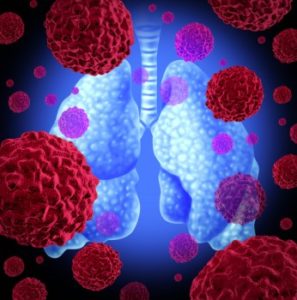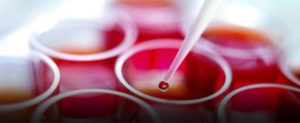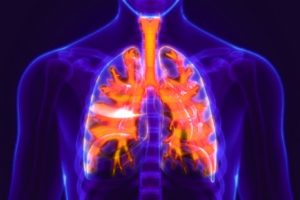Non-Small Cell Lung Cancer Specimens
Bay Biosciences provides high quality clinical grade fresh frozen sera (serum), plasma and peripheral blood mononuclear cells (PBMC) biofluid samples processed from patient’s whole blood using customized processing protocols, with matching tumor tissue samples from unique untreated Non-Small Cell Lung Cancer (NSCLC) patients diagnosed with advanced Stage III & IV Non-Small Cell Lung Cancer.

Non-Small Cell Lung Cancer (NSCLC) Overview
Lung cancer is a type of cancer that starts in the lungs. Non-small cell cancer is the most common kind of lung cancer. Non–small cell lung cancer (NSCLC) accounts for approximately 85% of all lung cancers in the United States. Non-small cell lung cancer is a disease in which malignant cancer cells form in the tissues of the lung.
Function of the Lungs
The lungs are a pair of cone-shaped organs in the chest. The lungs brings fresh air oxygen into the bloodstream for delivery to the rest of the body as you breathe in (inhale) and release carbon dioxide a waste product of the body’s cells as you breathe out (exhale).
The lungs contain many different types of cells. Most cells in the lung are epithelial cells. Epithelial cells line the airways and make mucus, which lubricates and protects the lung. The lung also contains nerve cells, hormone-producing cells, blood cells, and structural or supporting cells.
Non-Small Cell Lung Cancer
NSCLC begins when healthy cells in the lung change and grow out of control, forming a mass called a tumor, a lesion, or a nodule. A lung tumor can begin anywhere in the lung. A tumor can be cancerous or benign. Once a cancerous lung tumor grows, it may shed cancer cells. These cells can be carried away in blood or float away in the fluid, called lymph, that surrounds lung tissue. Lymph flows through tubes called lymphatic vessels that drain into collecting stations called lymph nodes.
Lymph nodes are the small, bean-shaped organs that help fight infection. They are located in the lungs, the center of the chest, and elsewhere in the body. The natural flow of lymph out of the lungs is toward the center of the chest, which explains why lung cancer often spreads there first. When a cancer cell moves into a lymph node or to a distant part of the body through the bloodstream, it is called metastasis.
Majority of lung cancers are Non-Small Cell Lung Cancers (NSCLC’s). Histologically, non-small cell lung cancer (NSCLC) is divided into three major histologic types, the main subtypes of NSCLC are adenocarcinoma, squamous cell carcinoma, and large cell carcinoma. These subtypes, which start from different types of lung cells are grouped together as NSCLC because their treatment and prognoses are often similar. Patients with NSCLC require a complete staging workup to evaluate the extent of disease, because stage plays a major role in determining the choice of treatment, chemotherapy, immunotherapy, or targeted therapy.
Smoking is the major risk factor for non-small cell lung cancer. The earlier in life a person starts smoking, the more often a person smokes, and the more years a person smokes, the greater the risk of developing lung cancer.
Signs of non-small cell lung cancer includes shortness of breath, chest discomfort and pain, trouble breathing, wheezing, blood in sputum, fever and a persistent cough that doesn’t go away and gets worse over time.

Types of Non-Small Cell Lung Cancer (NSCLC)
Non-Small Cell Lung Cancer begins in the epithelial cells. It is important for doctors to distinguish between lung cancer that begins in the squamous cells from lung cancer that begins in other cells. This information is used to determine treatment options.
Following are the different types of Non-Small Cell Lung Cancer are:
- Adenocarcinoma
- Squamous cell carcinoma
- Large cell carcinoma
- NSCLC-NOS (not otherwise specified) or NSCLC undifferentiated
Signs and Symptoms of Non-Small Cell Lung Cancer (NSCLC)
Following are some of the common signs and symptoms of Non-Small Cell Lung Cancer (NSCLC); Sometimes patients with NSCLC do not have any of these changes. Or, the cause of a symptom may be a different medical condition that is not cancer.
- Fatigue
- Cough
- Shortness of breath
- Fever
- Chest pain, if a tumor spreads to the lining of the lung or other parts of the body near the lungs
- Loss of appetite
- Coughing up phlegm or mucus
- Coughing up blood
- Unintentional weight loss
- Hoarseness
Non Small Cell Lung Cancer (NSCLC) can spread anywhere in the body through a process called metastasis. It most commonly spreads to the lymph nodes, other parts of the lungs, bones, brain, liver, and structures near the kidneys called the adrenal glands. Metastases from NSCLC can cause:
- More breathing difficulties
- Bone pain
- Abdominal or back pain
- Headaches
- Weakness
- Dizziness
- Seizures
- Speech difficulties
Risk Factors of Non-Small Cell Lung Cancer (NSCLC)
Non-Small Cell Lung Cancer (NSCLC) occurs most often in people who smoke or in those who have smoked in the past. However, people who don’t smoke can also develop NSCLC. The following factors may raise a person’s risk of developing NSCLC:
- Smoking and Tobacco Use:Tobacco smoke damages cells in the lungs, causing the cells to grow abnormally. The risk that smoking will lead to cancer is higher for people who smoke heavily and/or for a long time. Regular exposure to smoke from someone else’s cigarettes, cigars, or pipes can increase a person’s risk of lung cancer, even if that person does not smoke. This is called Environmental Tobacco Smoke (ETS) or secondhand smoking.Smoking marijuana and using electronic cigarettes may also increase the risk of lung cancer, but the actual risk is unknown.
- Asbestos: These are hair-like crystals found in many types of rock and are often used as fireproof insulation in buildings. When asbestos fibers are inhaled, they can irritate the lungs. Many studies show that the combination of smoking and asbestos exposure is particularly dangerous. People who work with asbestos in a job such as shipbuilding, asbestos mining, insulation, or automotive brake repair and who smoke have a higher risk of developing NSCLC. Using protective breathing equipment reduces this risk.
- Radon: This is an invisible, odorless gas naturally released by some soil and rocks. Exposure to radon has been associated with an increased risk of some types of cancer, including lung cancer.
- Genetics: Some people have a genetic predisposition for lung cancer. Even if they never smoke cigarettes, people with a parent, brother, or sister with lung cancer could have a higher risk of developing lung cancer themselves due to genetic changes.
- Other Substances: Other substances such as gases or chemicals at work or in the environment can increase a person’s risk of developing lung cancer. In some parts of the world, people exposed to cooking flames from coal or wood might increase risk of lung cancer. Also, fumes from diesel gas or from soldering metals could increase the risk of lung cancer. Other factors that may increase the risk of lung cancer include exposure to radiation, arsenic, nickel, and chromium.
Diagnosis of Non-Small Cell Lung Cancer (NSCLC)
The following tests may be used to diagnose and learn the stage of non-small cell lung cancer:
Cancer Imaging tests
Imaging scans are very important in the care of people with Non-Small Cell Lung Cancer (NSCLC). However, no test is perfect, and no scan can provide confirmed diagnoses of NSCLC. Only a biopsy can do that. Chest x-ray and scan results must be combined with a person’s medical history, a physical examination, blood tests, and information from the biopsy to form a complete picture of where the cancer began and if or where it has spread.
- CT scan
- Positron emission tomography (PET) scan
- Magnetic resonance imaging (MRI) scan
- Bone scan
- Biopsy
- Bronchoscopy
- Needle aspiration/core biopsy
- Thoracentesis
- Thoracoscopy
- Mediastinoscopy
- Thoracotomy
Molecular testing of the tumor
Your doctor may recommend running tests on a tumor sample to identify specific genes, proteins, and other factors unique to the tumor. There are several genes that may have changes, called mutations, in a lung tumor that can help the cancer grow and spread. These mutations are found in the tumor and not in healthy cells in the body. This means that they are not inherited or passed down to your children.
Genetic mutations that are known to contribute to lung cancer growth often occur on 1 or more of several genes, including EGFR, ALK, KRAS, BRAF, HER2, ROS1, RET, MET, and TRK. Testing the tumor for some of these genes is now common for later-stage NSCLC. Testing for these genes may also be done for earlier stages of the disease.
Results from these tests can help determine if you can receive targeted therapy, which can be directed at specific mutations. Mutations for which targeted therapies exist are much more likely to occur in people with the adenocarcinoma type of NSCLC and who never smoked. The stage of NSCLC is also important for determining if you can receive targeted therapy.
Your doctor may also recommend PD-L1 testing. PD-L1 is a protein found on the surface of some cancer cells and some of the body’s immune cells. This protein stops the body’s immune cells from destroying the cancer. Knowing if the tumor has PD-L1 helps your doctor decide if certain types of immunotherapy may be helpful. These types of immunotherapy block PD-L1 and allow the immune system to target the cancer.

Detailed clinical data, biomarker information and pathology annotations, biopsy data, patients smoking history, MRI, PFT tests associated with the Non-Small Cell Lung Cancer (NSCLC)sera (serum) and FFPE samples is provided to a valued pharmaceutical customer for research, drug discovery and development.
Bay Biosciences is a global leader in providing researchers with high quality, clinical grade, fully characterized human tissue samples, bio-specimens and human bio-fluid collections from cancer (tumor) tissue, cancer serum, cancer plasma cancer PBMC and human tissue samples from most other therapeutic areas and diseases.
Bay Biosciences maintains and manages it’s own bio-repository, human tissue bank (biobank) consisting of thousands of diseased samples (specimens) and from normal healthy donors available in all formats and types. Our biobank procures and stores fully consented, deidentified and institutional review boards (IRB) approved human tissue samples and matched controls.
All our human human tissue collections, human specimens and human bio-fluids are provided with detailed samples associated patient’s clinical data. This critical patient’s clinical data includes information relating to their past and current disease, treatment history, lifestyle choices, biomarkers and genetic information. Patient’s data is extremely valuable for researchers and is used to help identify new effective treatments (drug discovery & development) in oncology, other therapeutic areas and diseases. This clinical information is critical to demonstrate their impact, monitor the safety of medicines, testing & diagnostics, and generate new knowledge about the causes of disease and illness.
Bay Biosciences banks wide variety of human tissue samples and biological samples including cryogenically preserved -80°C, fresh, fresh frozen tissue samples, tumor tissue samples, FFPE’s, tissue slides, with matching human bio-fluids, whole blood and blood derived products such as serum, plasma and PBMC’s.
Bay Biosciences is a global leader in collecting and providing human tissue samples according to the researchers specified requirements and customized, tailor made collection protocols. Please contact us anytime to discuss your special research projects and customized human tissue sample requirements.
Bay Biosciences provides human tissue samples (human specimens) from diseased and normal healthy donors; including peripheral whole-blood, amniotic fluid, bronchoalveolar lavage fluid (BAL), sputum, pleural effusion, cerebrospinal fluid (CSF), serum (sera), plasma, peripheral blood mononuclear cells (PBMC’s), saliva, Buffy coat, urine, stool samples, aqueous humor, vitreous humor, kidney stones, renal calculi, nephrolithiasis, urolithiasis and other bodily fluids from most diseases including cancer. We can also procure most human bio-specimens and can do special collections and requests of human samples that are difficult to find. All our human tissue samples are procured through IRB approved clinical protocols and procedures.
In addition to the standard processing protocols Bay Biosciences can also provide human plasma, serum, PBMC bio-fluid samples using custom processing protocols, you can buy donor specific sample collections in higher volumes and specified sample aliquoting from us. Bay Biosciences also provides human samples from normal healthy donors, volunteers, for controls and clinical research, contact us Now.
日本のお客様は、ベイバイオサイエンスジャパンBay Biosciences Japanまたはhttp://baybiosciences-jp.com/contact/までご連絡ください。



